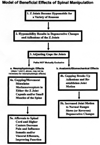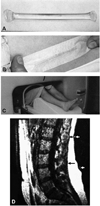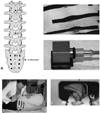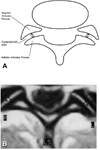Evaluating the relationship among cavitation, zygapophyseal joint gapping, and spinal manipulation: an exploratory case series
- PMID: 21237402
- PMCID: PMC3582390
- DOI: 10.1016/j.jmpt.2010.11.008
Evaluating the relationship among cavitation, zygapophyseal joint gapping, and spinal manipulation: an exploratory case series
Abstract
Objective: This project determined the feasibility of conducting larger studies assessing the relationship between cavitation and zygapophyseal (Z) joint gapping following spinal manipulative therapy (SMT).
Methods: Five healthy volunteers (average age, 25.4 years) were screened and examined against inclusion and exclusion criteria. High-signal magnetic resonance imaging (MRI) markers were fixed to T12, L3, and S1 spinous processes. Scout images were taken to verify the location of the markers. Axial images of the L4/L5 and L5/S1 levels were obtained in the neutral supine position. Following the first MRI, accelerometers were placed over the same spinous processes; and recordings were made from them during side-posture positioning and SMT. The accelerometers were removed, and each subject was scanned in side-posture. The greatest central anterior to posterior Z joint spaces (gap) were measured from the first and second MRI scans. Values obtained from the first scan were subtracted from those of the second, with a positive result indicating an increase in gapping following SMT (positive gapping difference). Gapping difference was compared between the up-side (SMT) joints vs the down-side (non-SMT) joints and between up-side cavitation vs up-side noncavitation joints.
Results: Greater gapping was found in Z joints that received SMT (0.5 ± 0.6 mm) vs non-SMT joints (-0.2 ± 0.6 mm), and vertebral segments that cavitated gapped more than those that did not cavitate (0.8 ± 0.7 vs 0.4 ± 0.5 mm).
Conclusions: A future clinical study is quite feasible. Forty subjects (30 in an SMT group and 10 in a control group) would be needed for appropriate power (0.90).
Copyright © 2011 National University of Health Sciences. Published by Mosby, Inc. All rights reserved.
Figures








References
-
- Cramer GD, Gregerson DM, Knudsen JT, Hubbard BB, Ustas LM, Cantu JA. The effects of side-posture positioning and spinal adjusting on the lumbar Z joints: a randomized controlled trial with sixty-four subjects. Spine (Phila Pa 1976) 2002;27(22):2459–2466. - PubMed
-
- Triano JJ. Interaction of spinal biomechanics and physiology. In: Haldeman S, editor. Principles and practice of chiropractic. 2nd ed. East Norwalk, Conn: Appleton & Lange; 1992. pp. 225–257.
-
- Mooney V, Robertson J. The facet syndrome. Clin Orthop Res. 1976;115:149–156. - PubMed
-
- Janse J. In: Principles and practice of chiropractic: an anthology. Hildebrandt RW, editor. Wheaton: Kjellberg & Sons; 1976. p. 326.
-
- Pickar JG. An in vivo preparation for investigating neural responses to controlled loading of a lumbar vertebra in the anesthetized cat. J Neurosci Meth. 1999;89:87–96. - PubMed
Publication types
MeSH terms
Grants and funding
LinkOut - more resources
Full Text Sources
Medical
Miscellaneous

